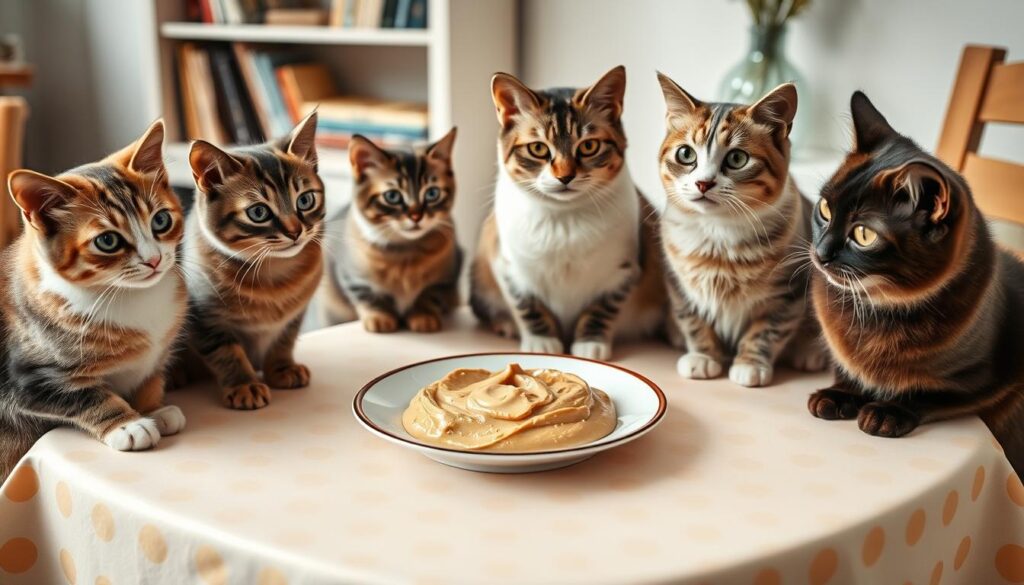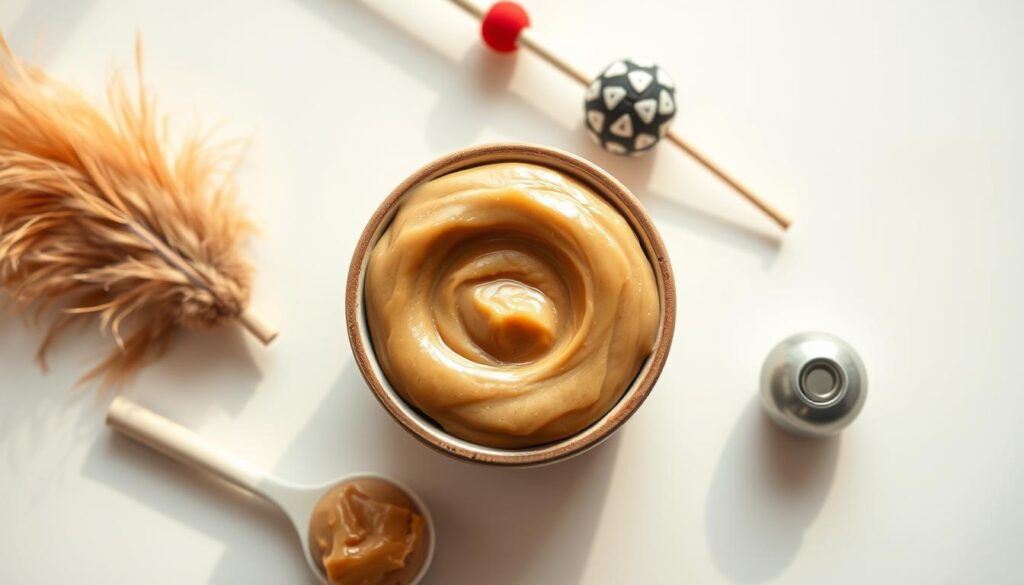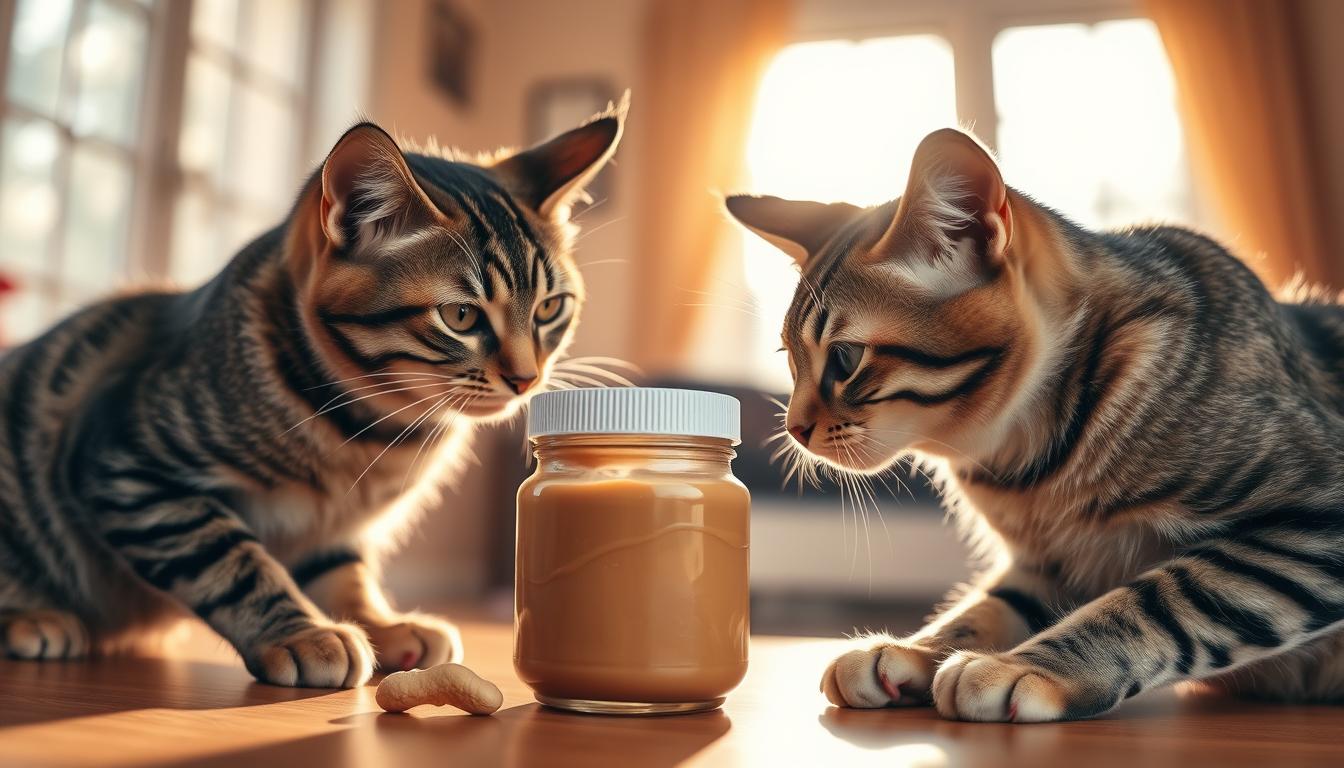can cats eat peanut butter: Have you ever caught your cat staring at your peanut butter sandwich? They seem curious about the creamy spread. The question of whether cats can eat peanut butter puzzles many pet owners.
As a cat parent, you might want to share snacks safely. But is peanut butter safe for cats? The answer isn’t simple. While small amounts without xylitol aren’t toxic, cats can’t digest it well. They need protein-rich diets, not fat or sugar.
Key Takeaways
- Peanut butter contains no essential nutrients for cats and may cause obesity due to its 72% fat content.
- Xylitol, found in many brands, can cause severe hypoglycemia in cats within 30 minutes of ingestion.
- Even “safe” amounts risk allergies or gastrointestinal upset, as cats are obligate carnivores.
- Petcube Pops offer a safer 2-calorie treat alternative to peanut butter.
- Always check labels for xylitol and consult your vet before sharing human foods.
The Truth About Cats and Peanut Butter
Cats and peanut butter might seem like an odd mix, but many pet owners wonder why their cats like it. It’s important to know that curiosity doesn’t mean it’s safe. Let’s look into the facts behind this question.
Why Cats Might Be Attracted to Peanut Butter
Cats have a keen sense of smell and find peanut butter’s aroma and sweetness appealing. They are drawn to fats, but their bodies aren’t made for eating plants. The smell makes them think it’s a treat, but they miss out on important nutrients.
The Natural Diet of Felines vs. Human Foods
Cats need animal protein to survive because they are obligate carnivores. They can’t digest plant-based foods like peanuts. A tablespoon of peanut butter has 100 calories and 72% fat, but it lacks essential nutrients for cats. This can be risky, even if they like the taste.
Understanding Your Cat’s Digestive System
- Cats lack enzymes to digest carbohydrates and plant oils efficiently.
- High-fat content can overwhelm their livers and cause digestive upset.
- Plant proteins in peanut butter don’t provide taurine, a vital amino acid cats must get from meat.
Regularly feeding peanut butter can upset their cats peanut butter diet balance. It can lead to obesity or nutrient deficiencies. It’s better to focus on their natural diet needs rather than treats.
Can Cats Eat Peanut Butter Safely?
The question can cats eat peanut butter is often asked. But, the answer is not simple. While a little peanut butter is not toxic, it lacks nutritional value. Always check the label to make sure it doesn’t have xylitol, which is harmful to cats.
| Nutrient | Percentage in Peanut Butter | Cat’s Needs |
|---|---|---|
| Carbohydrates | 14% | Low |
| Protein | 14% | High |
| Fat | 72% | Moderate |
The makeup of peanut butter shows it’s not good for cats. They need more protein, not fats or carbs. A tablespoon has 100 calories, which can cause weight gain. The sticky texture can also cause choking.
- Always choose unsalted, xylitol-free brands.
- Offer less than a pea-sized portion.
- Monitor for swelling, vomiting, or breathing issues.
If your cat has diabetes or pancreatitis, avoid peanut butter. Talk to a vet before giving it to your cat. It’s better to stick to balanced meals than treats.
Potential Health Risks of Feeding Peanut Butter to Cats
Feeding peanut butter to cats can be risky. Is peanut butter safe for cats? It depends on what’s in it and how much you give. Even a little can be harmful.
“Cats are obligate carnivores requiring animal protein. Peanut butter provides no essential nutrients and may introduce harmful additives.” – R.L. Remillard & S W. Crane, 2010
Here’s why peanut butter is a problem for cats:
- It’s very fatty, which can lead to obesity and pancreatitis.
- Some peanut butters have xylitol, which can cause serious health problems.
- The sticky texture can cause choking, especially with whole peanuts.
High Fat Content and Obesity Concerns
A tablespoon of peanut butter has 100 calories, almost 10% of a cat’s daily needs. This can cause weight gain. Too much fat can hurt the pancreas, increasing the risk of pancreatitis.
Being overweight also raises the risk of diabetes and joint problems in cats.
| Nutrient | Per 100g |
|---|---|
| Calories | 597 kcal |
| Carbs | 22g |
| Protein | 22.5g |
| Fat | 51g (72% of total) |
Choking Hazards and Difficulty Swallowing
Peanut butter is sticky and can block airways if swallowed too fast. Whole peanuts in jars can cause choking or blockages in the intestines. Signs of trouble include gagging, coughing, or hard breathing.
Xylitol Toxicity: A Hidden Danger
Some peanut butters, like Jif or Skippy, have xylitol. This can cause insulin spikes. Symptoms include vomiting, weakness, and seizures. Without help, it can lead to liver damage and death.
Even a small amount of xylitol can be deadly. If you think your cat ate it, call a vet right away. Always put your cat’s health first.
Nutritional Analysis: What’s in Peanut Butter?
Peanut butter is not good for your cat’s diet. It smells interesting to cats, but it’s full of calories.
Fat, Protein, and Carbohydrate Content
Peanut butter has 72% fat, 14% protein, and 14% carbs per 100 grams. The fat can hurt a cat’s stomach and cause pancreatitis. The protein is from plants, not meat, and lacks taurine, which cats need.
Cats can’t digest carbs well. The 22 grams in peanut butter don’t help them.
Salt and Sugar Concerns for Feline Health
- Sodium: Too much salt can harm a cat’s kidneys and cause dehydration.
- Sugar: Sugars in peanut butter can lead to obesity and tooth problems, but they’re not good for cats.
Additives and Preservatives to Watch For
Commercial peanut butters often have additives and preservatives. These include BHA/BHT, which aren’t safe for cats. Even without xylitol, other harmful additives might be present. Always read labels carefully.
Thinking about peanut butter for cats means focusing on their meat-based diet. A tablespoon has almost 100 calories, too much for small animals. Choose vet-approved treats instead, like lean meats or cat-specific treats.
Cats Peanut Butter Allergies: Signs to Watch For
Peanut butter isn’t toxic to cats, but cats peanut butter allergies can happen. If your cat eats peanut butter, look for odd behavior or physical signs.
- Itchy or red skin, especially around the face or paws
- Vomiting, diarrhea, or loss of appetite
- Swellinging of the face, ears, or paws
- Increased scratching or hair loss
- Difficulty breathing or wheezing
| Sign | Possible Cause |
|---|---|
| Ear scratching or head shaking | Could indicate an allergic response |
| Diarrhea or vomiting | Might signal a digestive allergic reaction |
| Swellinging of the throat | Emergency: Seek help immediately |
If your cat shows these signs after eating peanut butter, stop giving it to them right away. Severe reactions like collapse or trouble breathing need quick vet care. Always check with your vet before giving your cat human food, even if is peanut butter safe for cats seems okay. Watch your cat closely and have your vet’s emergency number ready.
How Much Peanut Butter Is Too Much for Your Cat?

If you’re wondering can cats eat peanut butter, the answer is yes, but only in small amounts. A tablespoon of peanut butter has almost 100 calories. This is half of what a 10-pound cat needs in a day. So, treat peanut butter as a rare treat in your cat’s diet.
Recommended Serving Sizes (If Any)
Here are some guidelines to avoid overfeeding:
- Maximum of ½ teaspoon per serving
- No more than twice a month as a treat
- Aim for pea-sized portions to match their small size
Frequency Guidelines for Treating Your Cat
Treats should never make up more than 10% of your cat’s daily calories. For a 250-calorie diet, that’s just 25 calories max. Here’s how to stay safe:
- Offer peanut butter no more than twice weekly
- Track treats as part of their overall diet
- Choose xylitol-free brands and check labels for additives
A ¼-tablespoon serving provides about 25 calories—use it sparingly. Over time, even this small amount can contribute to weight gain or digestive upset. Always consult your vet before introducing new foods. While cats peanut butter diet inclusion is possible, it should never replace their regular nutrition.
Safer Alternatives to Peanut Butter for Cats
Many cat owners wonder if peanut butter for cats is safe. They look for treats that are good for their pets. Luckily, there are safer choices that can satisfy your cat’s curiosity without risks.
“Cats are obligate carnivores, so their treats should prioritize animal proteins over processed human foods like peanut butter.” — American Veterinary Medical Association
Cat-Friendly Treats with Similar Appeal
Choose treats that are made with your cat’s health in mind. Brands like Wellness Soft Bites and Blue Buffalo Tender Bites offer protein-rich options. Look for:
- High-protein recipes with real meat as the first ingredient
- Grain-free formulas to avoid digestive upset
- Small, bite-sized pieces for easy chewing
Homemade Options That Are Safer Than Peanut Butter
Homemade recipes can replace peanut butter safely. They avoid xylitol and sodium:
- Cooked proteins: Plain, shredded chicken or turkey (no seasoning)
- Fish alternatives: Tiny pieces of tuna or salmon (limit due to mercury concerns)
- Plant-based treats: Fresh catnip or cat grass for nibbling
Always talk to your vet before trying new foods. Choose options that are close to a cat’s natural diet—animal proteins and low-carbs—instead of human snacks.
Using Peanut Butter as a Tool: Medication Administration
Some cat owners use peanut butter for cats to hide the taste of pills. But, it’s important to think about the risks like weight gain and stomach problems. Cats and peanut butter shouldn’t be a long-term solution.

- Use a pea-sized amount: Enough to coat the pill, not as a meal.
- Opt for unsweetened, xylitol-free brands to minimize sugar intake.
- Track calories: A 10-lb cat should never exceed 250 kcal daily, per University of California findings.
Instead of peanut butter for cats, try Science Diet pill pockets or commercial pill pastes. They’re low in fat and help cats swallow pills. For liquid meds, syringes or tuna juice might be better than sticky nut butters.
| Option | Pros | Cons |
|---|---|---|
| Peanut Butter | Masks pill taste | Risk of weight gain |
| Pill Pockets | Low-calorie, vet-approved | May require gradual introduction |
| Liquid Meds | No added calories | Not all medications work in liquid form |
Always put your cat’s health first: talk to a vet before using peanut butter. Mix medication with something positive, like praise or a favorite treat. This helps build trust over time.
Other Nut Butters and Their Safety for Feline Consumption
Some cat owners try cats and nut butters instead of peanut butter. But most nut butters are too fatty and calorie-rich.
“Cats need a diet rich in meat proteins. Nut butters offer no nutritional value and can be harmful,” a 2010 study by veterinarians Remillard and Crane found.
Almond Butter vs. Peanut Butter for Cats
Almond butter has less fat than peanut butter but is still high in calories. Both can upset a cat’s stomach with their oils and sugars. Cats and nut butters should not be a regular part of their diet, even if they like them.
Sunflower Seed Butter as an Alternative
- Sunflower seed butter has less fat than most nut butters but still lacks essential nutrients for cats.
- Its seed base doesn’t change the risk of digestive upset or obesity.
- Cats eating nuts or seeds in large amounts may face pancreatitis or intestinal blockage.
Dangers of Specific Nut Butters for Cats
Some nut butters have hidden dangers:
- Macadamia nut butter: Contains toxins causing weakness and tremors.
- Walnut butters: Risk of aflatoxins from mold, linked to liver damage.
- Xylitol-sweetened butters: Can cause hypoglycemia, even in small amounts.
All nut butters are choking hazards because of their sticky texture. Always check labels for additives like salt or sugar. These can lead to dehydration or kidney strain.
What Veterinarians Say About Cats and Peanut Butter
Veterinarians say is peanut butter safe for cats is a tricky question. While cats can eat a little peanut butter without harm, it’s not good to feed it often.
“Peanut butter isn’t a natural part of a cat’s diet. It lacks essential nutrients like taurine and offers no nutritional value cats can’t get from their regular food.”
- Vets warn that even small servings contribute excess calories (about 100 calories per tablespoon), which can lead to obesity in indoor cats.
- High-fat content strains a cat’s pancreas, increasing pancreatitis risk—a condition common in cats fed fatty human foods.
- Xylitol, present in some brands, causes rapid insulin spikes and liver damage. Always check labels!
Cats need food made just for them. They can’t handle high carbs or plant proteins in peanut butter. The cats and peanut butter mix also poses a choking hazard because of the sticky texture. Experts advise sticking to cat treats that have important amino acids like arachidonic acid.
Many clinics advise against giving cats human food unless a vet says it’s okay. For example, ASPCA poison control reports show xylitol in peanut butter accounts for 15% of feline toxicity cases. Always talk to your vet before giving your cat human snacks, even if they seem safe like peanut butter.
Conclusion: Making Informed Decisions About Your Cat’s Diet
When deciding whether to offer peanut butter, prioritize your cat’s health. Can cats eat peanut butter? Small amounts without xylitol may not cause immediate harm. But, it’s not part of a healthy cats peanut butter diet.
Cats do best on high-protein meals from animal sources, not sugary snacks. Their bodies process carbs poorly, making treats like peanut butter risky for weight gain or diabetes.
Cats are obligate carnivores needing 70% of calories from meat. A 13–18 pound cat requires 400–600 calories daily, best met through commercial cat food. Peanut butter’s fat and sugar lack essential nutrients like taurine, which cats can’t survive without.
Over time, such treats disrupt their nutritional balance, risking deficiencies.
If you choose to offer tiny amounts, always check for xylitol—a toxic additive. Prioritize safer options like chicken-based treats or vet-approved alternatives. Homemade recipes using cooked meats or commercial cat treats ensure proper nutrition without risks.
Always consult your vet before introducing new foods.
Remember, even small indulgences matter. Focus on diets rich in animal protein to support your cat’s health. Avoid human foods high in salt, sugar, or additives.
Regular vet checkups help ensure your cat’s diet aligns with their biological needs, preventing long-term health issues. Prioritize their carnivore biology to keep them thriving.
FAQ
Can cats eat peanut butter?
Is peanut butter safe for cats?
What are the risks of feeding peanut butter to cats?
Are there any nutritional benefits of peanut butter for cats?
How can I identify a peanut butter allergy in my cat?
How much peanut butter can I give my cat?
What are some safer alternatives to peanut butter for cats?
Can I use peanut butter to hide my cat’s medication?
Are there other nut butters safe for feline consumption?
What do veterinarians think about cats eating peanut butter?
Source Links
- Can Cats Eat Peanut Butter? The Definitive Answer – https://michupet.com/blogs/nutrition/can-cats-have-peanut-butter?srsltid=AfmBOooT_RiIcVo1ZlxDhcudtTe62pVKnpjcMay1i1UHBaNlmODDVxkF
- Can Cats Have Peanut Butter? – https://petcube.com/blog/can-cats-have-peanut-butter/
- 9 Human Foods That Are Safe for Your Kitty to Snack On – https://www.dailypaws.com/cats-kittens/cat-nutrition/what-can-cats-eat/human-foods-for-cats
- Can Cats Eat Peanut Butter? Vet-Reviewed Facts & FAQ – Catster – https://www.catster.com/nutrition/can-cats-eat-peanut-butter/
- Can Cats Eat Peanut Butter? The Definitive Answer – https://michupet.com/blogs/nutrition/can-cats-have-peanut-butter?srsltid=AfmBOoou0RXkOViP7xlEmg4dC9-AEbOK-pqiNixSuxOgt36_zO5yZpS2
- Can My Cat Eat That? The Most Commonly Asked Culprits Answered by a Veterinarian – https://www.hamptonveterinaryhospital.com/services/blog/can-my-cat-eat-most-commonly-asked-culprits-answered-veterinarian
- Can Cats Eat Peanut Butter? The Definitive Answer – https://michupet.com/blogs/nutrition/can-cats-have-peanut-butter?srsltid=AfmBOoqN_bqKIJMwfahoseUDdUF96RCiI37dz-Ppx92J3_EKU-D5xYb1
- Can Cats Eat Peanut Butter? | Safe or Harmful for Cats – https://felinefancy.co.uk/blogs/cat-care-tips/can-cats-eat-peanut-butter?srsltid=AfmBOooK2ze7y-Y7-8ndQT3zINnJoPQSRKLBMvsvoJb90PGi0N2k31w9
- Can Cats Eat Peanut Butter? The Definitive Answer – https://michupet.com/blogs/nutrition/can-cats-have-peanut-butter?srsltid=AfmBOopN5jvr9SMwynlETokxF9Ng-aXCosg3_N2sAnOzB71pNvXd26m0
- What Cats Can and Can’t Eat │ Food for Cats│ Post Office – https://www.postoffice.co.uk/pet-insurance/guides/what-cats-can-eat
- Can Cats Eat Peanut Butter? | Safe or Harmful for Cats – https://felinefancy.co.uk/blogs/cat-care-tips/can-cats-eat-peanut-butter?srsltid=AfmBOorW9ydIm6sBR4rBXaQ7qhDVs27dlaGG99TGO5CWa_AnxXgEQir_
- Can Cats Eat Peanut Butter? The Definitive Answer – https://michupet.com/blogs/nutrition/can-cats-have-peanut-butter?srsltid=AfmBOoqjcTlpgixIdIVRY4sOyvF2FZ7twK5M-ts1A9DJcPKsSokfXxoV
- Can Cats Eat Peanut Butter? The Definitive Answer – https://michupet.com/blogs/nutrition/can-cats-have-peanut-butter?srsltid=AfmBOoqK7gCkEeXor9qjum5tiSzZa5lghcP-y-oK8wCU3cDrZK_eyg2K
- Can Cats Eat Peanuts? Human Food for Cats – https://www.kinship.com/cat-nutrition/can-cats-eat-peanuts
- Can Cats Eat Peanut Butter? The Ultimate Answer and Useful Tips – Total Vet – https://total.vet/can-cats-eat-peanut-butter/
- Can Cats Eat Peanut Butter + Peanuts? Is It Toxic To Them? – https://www.bellaandduke.com/cats/expert-advice/cat-nutrition/can-cats-eat-peanut-butter/
- Can Cats Eat Peanut Butter? The Definitive Answer – https://michupet.com/blogs/nutrition/can-cats-have-peanut-butter?srsltid=AfmBOopvnWCu4sXJ7mGUwtDRAmtBr41z9H19yrgpdjzMzIr7rQNho2Mu
- Can Cats Eat Peanut Butter? | Safe or Harmful for Cats – https://felinefancy.co.uk/blogs/cat-care-tips/can-cats-eat-peanut-butter?srsltid=AfmBOoohshGUgHmBcquk5qyDStBvPenoLJNoE–hp-TA8p9z54Yl9fE2
- How To Give Oral Medication To Dogs And Cats | West Delray Veterinary – https://westdelrayvet.com/how-to-give-oral-medication-to-dogs-and-cats/
- How Much To Feed a Cat – https://www.petmd.com/cat/nutrition/how-much-to-feed-a-cat
- Can Cats Eat Peanut Butter? Human Food for Cats – https://www.kinship.com/cat-nutrition/can-cats-eat-peanut-butter
- Can Cats Eat Peanut Butter? The Definitive Answer – https://michupet.com/blogs/nutrition/can-cats-have-peanut-butter?srsltid=AfmBOop0zRQbE5qPvC5-Ow9DkqXeoSWDVrk8JgJtuSa0U3OUrdt1u-65
- Can Cats Eat Nuts? Human Food For Cats – https://www.kinship.co.uk/cat-nutrition/can-cats-eat-nuts
- Can Cats Eat Peanut Butter? The Definitive Answer – https://michupet.com/blogs/nutrition/can-cats-have-peanut-butter?srsltid=AfmBOopSIVSt9snTjqYLEZev5BxDgyfed8vcjHFsR07xJFCyYf4BZYAo
- 15 Toxic Human Foods You Should Never Feed Your Cat – https://www.dailypaws.com/foods-toxic-to-cats-7494337
- Can My Cat Eat That? The Most Commonly Asked Culprits Answered by a Veterinarian – https://www.theuniversityanimalclinic.com/services/blog/can-my-cat-eat-most-commonly-asked-culprits-answered-veterinarian
- Maine Coon Cats and Pizza: Dietary Considerations – https://www.petzooie.com/articles/can-maine-coon-cats-eat-pizza
- Can Cats Eat Cookies? – https://taylorchip.com/blogs/news/can-cats-eat-cookies?srsltid=AfmBOora3qnY_LCbvXMf1mLsVpwK4qUPq7XJyIHhHyMO6AM-rquvatgh
